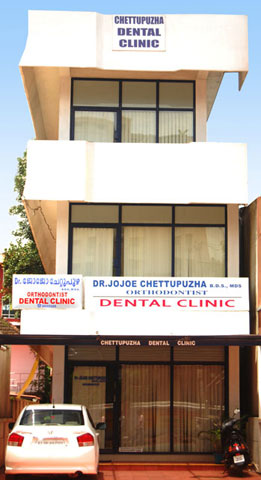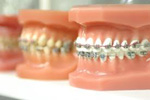|
 |
ORTHODONTICS
|
What is Orthodontics?
Orthodontics is the branch of dentistry that is officially known as
Orthodontics and Dentofacial Orthopaedics.
The purpose of Orthodontics is to treat any type of "bad bites",
malocclusion, protruded teeth, Crowded/misaligned teeth,
abnormal jaw shapes or size etc.....
Why Orthodontics?
Crooked and Crowded teeth are hard to clean and maintain. This
Contributes to tooth decay, gum disease and tooth loss.
A bad bite also causes abnormal wear of tooth surface, difficulty in
chewing and/ or speaking, excessive stresses on supporting bone and
gum tissue, and potential jaw joint problems.
children and adults whose malocclusions when left untreated may go
through life reduced self esteem and lack of confidence, affecting their
performance in all sphere of life.
Many problems if left untreated worsen with time and may require
extensive dental care later.
Who is an Orthodontist?
A qualified Orthodontist is a dental specialist in the diagnosis,
prevention and treatment of facial and dental irregularities. all
Orthodontists
are Dentists but only a very small percentage of Dentists are
Orthodontists. Admission to Orthodontic specialty programmes is
extremely competitive and selective.
It requires 3 years of rigorous and demanding training after becoming a
dentist to qualify as an Orthodontist. Every dental specialist with an
MDS Degree is not an Orthodontist, as dentistry has many branches of
specialization.
You are in the office of a qualified Orthodontist who has the vision,
foresight and the skills to proficiently place Orthodontics appliances
and achieve corrections for your teeth, jaws and face that will last a
life time
What causes Orthodontic problems?
Most Orthodontic problems are inherited. Examples of these problems,
which have a genetic component are crowding, spacing, protrusion and
facial deformities.
Other problems are acquired. They may be because of thumb or finger
sucking, mouth breathing, dental disease, abnormal swallowing, poor
dental hygiene, the early or late loss of milk teeth, loss of permanent
teeth due to accidents, poor nutrition.
or related medical problems. An inherited condition may be complicated
by an acquired problem. your Orthodontist will be able to treat most
conditions successfully.
What does treatment involve?
Most importantly, Orthodontics treatment involves the patient to achieve
good results, the patient must follow the doctor's instructions about
wearing Orthodontics appliances and practice good oral hygiene. With
braces, certain foods like nuts, chewing gums, Chocolates and Caramel,
Chips, Hard Fruits, fast foods that require heavy chewing has to be
avoided.
How do braces or orthodontic appliances work?
Braces work to move teeth and their accompanying tissues through the
bone.
they are capable of manipulating the growth of facial bones as well. The
principle involved here is that pressure causes bone to resorb and
tension causes new bone formation.
Orthodontic appliances are proficient in delivering precise forces at
desired location on the teeth and jaw bones to bring about subtle
changes in a calibrated and sequential manner proven by years of
scientific and clinical research.
What is the best time for Treatment ?
Orthodontists recommended the first orthodontic check-up at 7 -9 years
of age. Most treatment procedures begin between the ages of 9 and 12 .
but Orthodontists can spot problems are easier to correct if found at an
early stage.
While your child's teeth may appear to be straight, there could be a
problem which only an Orthodontist can detect.
Orthodontic treatment today is possible and successful at any age.
Adults with healthy bones and gums are increasingly opting to braces.
It's never too late to get a healthy, beautiful smile!!!.
For a smile that lasts a life time...
A Start dental visits for your child after the first birthday.
B Visit your dentist regularly once in 8-12 months.
C Take your child an Orthodontic Check-up even if he/she is past
age 7. Although an early check -up is most beneficial, most orthodontic
patients begin active treatment between ages 9 and 12
D Orthodontic treatment also benefits adults. Newer advanced
types of braces make any age respond well to treatment.
E Choose an orthodontist, who is a member of the Indian
Orthodontic society- as he/ she is a dental specialist uniquely
qualified to treat orthodontic problems.
F Orthodontic treatment always has convenient payment plans. make
use of them.....
G Successful Orthodontic treatment is the result of a good
partnership between a co-operative patient & the Orthodontist, to create
a
healthy and beautiful smile that lasts a life time......
|
 |
|
|
|

